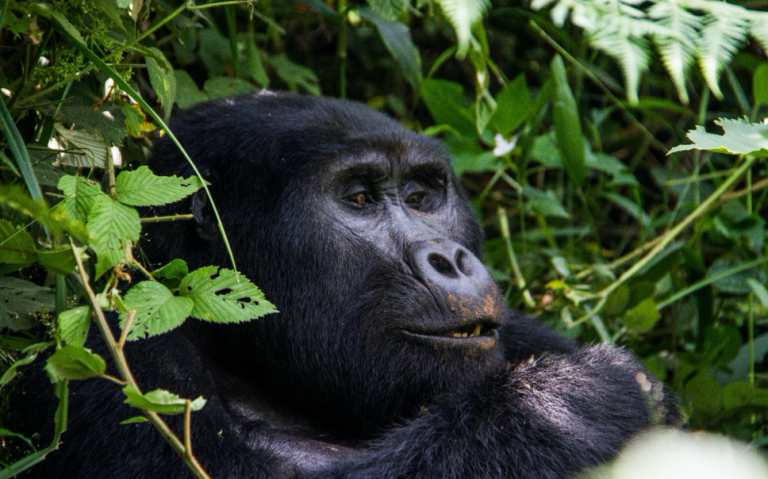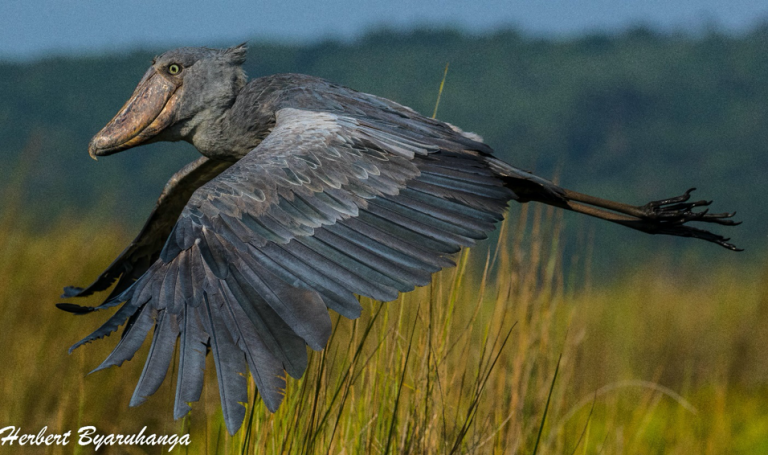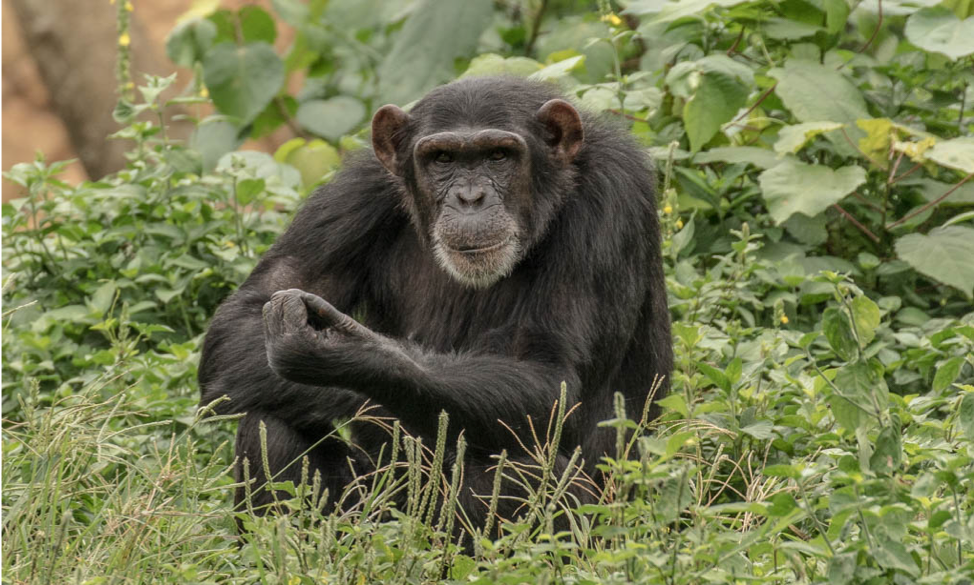Shoebill, Gorilla and Chimps in 1 Week!



Tour Date:
June 28-July 4, 2025. Extension runs to July 9.
Tour Price (Per Person):
2025 price $4950 plus $700 for Gorilla permit. Max 8 people group.
Price includes Chimpanzee permit, upgraded lodges with full board in the best birding areas, and flight back to connect with international travel.
Single supplement: $320.
Tour Type:
Easy birding and wildlife
Description
Name three things you want to see in Uganda! Easy, right?
Shoebill, Gorilla and Chimpanzee! Yet, all the birding trips to Uganda are so long, and so expensive.
What if you could see all three (OK..no guarantees… but a very good chance) and only take 5 days off from work.
The price per day is still quite high, but time is money and in the end you will see your bucket list species at a fraction of the price of big birding companies.
Birding highlights include a special effort to get representatives of African bird families such as Modulatricidae (Gray-chested Babbler), Flufftail and Green-breasted Pitta.
Additionally, you have a good shot at 23 of the Albertine Rift endemics as well as many iconic African mammals.
It is possible to add extension before and after the core trip for more birding and wildlife.
Here is the excellent trip report that Ian Reid made for our pilot trip in 2022. Many of the suggestions of improvements have been implemented in the new itinerary.
Part 1. Shoebill.
Part 2. Gorilla.
Part 3. Chimpanzees and Green-breasted Pitta.
DETAILED ITINERARY
After our successful July, 2022 trip, we have made several improvements to the trip to make sure everyone, even non-birders, will get the most out of the standard itinerary, and then added additional days to the end as an extension to give more hard core birders very good coverage of the Albertine Rift endemics. Those not taking the extension will need to book very early to make sure there are flights available to Entebbe.
Let us know if you have a preference!
Here is the outline of the 2025 standard program and the birder’s extension. Prices and details will be ready by late 2024 at the latest.
Drive to Bwindi. Preferably staying at Broadbill Forest Camp, Ruhija. Birding in the park in the late afternoon.
Day 7. Fly back from Kihihi airstrip to Kajjansi airstrip with bus transfer to Entebbe. Evening international flights.
Price: $4950
———————————————
Program 2022
For your information below follows the 10 day itinerary from July, 2022.
The big difference in 2025 is reversing the itinerary and adding stops at Queen Elizabeth National Park, the possibility to fly back to make a truly short Uganda trip for anyone with limited time and principally targeting the best of Uganda, and for the birder having the necessary time for most of the Albertine Rift endemics with ample time in two sectors of the Bwindi Impenetrable forest as well as Mgahinga National Park during the extension which shall be more traditional birdwatching.
Day 1: July 21, 2022. Arrival
Transfer to Entebbe hotel near Botanical gardens.
Day 2: July 22. Birding to Mabamba Wetlands. Shoebill.
Early breakfast, then out to nearby Mabamba Wetlands on the shores of Lake Victoria. This is one of the few remaining swamps in the country protected by the local communities – an extensive papyrus swamp with its labyrinth of channels and lagoons, classified as an Important Bird Area, and home to several pairs of Shoebills, Uganda’s most famous avian resident. This charismatic monotypic species is certainly amongst the most sought-after birds in Africa, and we’ll make special efforts today to find it by paddling through the channels by boat.
There will of course be a good selection of classic East African water birds, including Pink-backed Pelican, Long-tailed Cormorant, Goliath Heron, African Open-billed, Saddle-billed, and Marabou Storks, Hammerkop, White-faced Whistling-Duck, Yellow-billed Duck, African Fish-Eagle, African Marsh-Harrier, African Water Rail, Purple Swamphen, Allen’s Gallinule, African Jacana, Long-toed and Spur-winged Plovers. Apart from the numerous water birds, we are likely to see a nice variety of open country and water edge species, perhaps including Speckled Pigeon, African Green Pigeon, Eastern Plantain-eater, Malachite, Giant, and Pied Kingfishers, Blue-headed Coucal, Blue-breasted Bee-eater, Crowned Hornbill, Angola and Rufous-chested Swallows, Winding Cisticola, Greater and Lesser Swamp-Warblers, Swamp Flycatcher, Scarlet-chested Sunbird, Papyrus Gonolek, Slender-billed, Northern Brown-throated, and Golden-backed Weavers, and Papyrus Canary.
In the afternoon we shall drive to Lake Mburo. Stay at Rwakobo Rock Lodge.
Day 3. July 23. Mburo to Mgahinga.
We shall check out the rich wetland for waterbirds and many classical raptors including African Fish-Eagle and Lappet-faced Vulture. Additionally, a good chance to see the uncommon Red-faced Barbet.
Mid-morning we continue to drive to Mgahinga.
This is Uganda’s smallest and probably most scenic national park situated in the extreme south- western corner of the country on the slopes of the Virunga Volcanoes which rise up to 4000 m in elevation. To the south of the park is Rwanda, and to the west is the Democratic Republic of Congo. The park has a nice variety of Albertine rift endemics
Day 4: July 24. Mgahinga to Bwindi.
We shall explore the treasures of this park along the excellent Gorge trail, which loops half way up Mt. Sabinyo, traversing a variety of montane habitats. One trail winds up through former farmland where regenerating vegetation has a semi-natural heath character. Here we’ll look for Dusky Turtle- Dove, Cape Robin-chat, Brown-Crowned Tchagra, Bronze Sunbird, Rwenzori Turaco, Shelly’s Crimson-wing, Kivu Ground Thrush, Black-headed Waxbill, and Streaky Seedeater, all of which favor the scrubby early successional habitat in this area. As we climb and enter the bamboo belt at about 2500m, we may encounter the Handsome Francolin, Kivu Ground Thrush, and Cinnamon Bracken Warbler. The flowering Red-hot Pokers attract Malachite, Scarlet-tufted, and Ruwenzori Double-collared Sunbirds, as well as Lagden’s Bush-Shrike. Many of these are Albertine Rift endemics, which we can see here and at our next location at Bwindi Impenetrable National Park. The beautiful Golden Monkey, a localized form of the Blue Monkey, occurs in the bamboo zone and Mountain Gorillas are seasonally resident in the park (although we are unlikely to see one).
Mid-morning or afternoon, we continue to drive to Bwindi Impenetrable Forest.
Bwindi National Park is a UNESCO World Heritage Site and is home to approximately half of the world endangered population of Mountain Gorillas. This vast reserve offers arguably the most productive montane forest birding in Africa and supports 23 of Uganda’s 24 Albertine Rift endemic bird species.
Once part of a much larger forest that included the Virunga Volcanoes in neighboring Rwanda, Bwindi Impenetrable National Park is now an ecological island within a sea of human cultivation and therefore of big conservation importance.
Forest Birding at Bwindi provides some of the best bird watching in Uganda and Africa as well, having been voted as the Number One Hotspot in Africa by African Bird Club Members.
Stay at Ichumbi Gorilla Lodge.
Day 5: July 25. Gorilla tracking
After an early breakfast, you will report to the park headquarters for briefing prior to the gorilla tracking excursion. This activity may take anywhere between 1 hour and 8 hours, so a reasonable degree of fitness is required. It is a wonderful experience to stare into the eyes of these gentle giants; watch them in awe as they play and go about their daily activities. It is indeed a “once in a lifetime” experience that you must never miss. Each encounter is different and has its own rewards, but you are likely to enjoy the close view of adults feeding, grooming and resting as the youngsters’ frolic and swing from vines in a delightfully playful display.
The rest of the day we spend birding in the surroundings.
Stay at Ichumbi Gorilla Lodge.
Day 6-7: July 26-27. Additional birding in the Bwindi and Ruhija area.
We are tracking down Albertine Rift endemics one by one, also visiting the trails around Mubwindi swamps.
Special effort will be made to try to see Gray-chested Babbler (Illadopsis or Kakamega) – a rare member of the Dapplethroat family Modulatricidae.
Ruhiija is likely to be one of the highlights of any bird watching safari to Uganda with excellent birding in spectacular surroundings. The Birds are many here and somehow easy to see; many bird species associating in mixed feeding flocks that are active throughout the day. An early start offers the best chance of finding the striking Dwarf Honeyguide, Stripe-breasted Tit, Ruwenzori Apalis, African Hill Babbler (sometimes treated as a separate species from Ruwenzori Hill Babbler), the rare and localized Grauer’s Scrub-Warbler and Carruther’s Cisticola. Some of the many species we have a chance of seeing here include Black Goshawk, Augur Buzzard, Crowned Hawk-Eagle, Handsome Francolin, Olive (Rameron) Pigeon, Bronze-winged Pigeon, Black-billed, Ruwenzori, and Ross’s Turacco, African, Barred Long-tailed, and African Emerald Cuckoos, Red-chested Owlet, Narina and Bar-tailed Trogons, Black and Cinnamon-chested Bee-eaters, Blue-throated Roller, White-headed Woodhoopoe, Gray-throated, Double-toothed, and Yellow-spotted Barbets, Western and Yellow-rumped Tinkerbird, Thick-billed and Dwarf Honeyguides, Rufous-necked Wryneck, Tullberg’s, Speckle-breasted, Elliot’s, and Olive Woodpeckers, African Broadbill, Rock Martin, Black Saw-wing, Gray and Petit’s Cuckoo-Shrike, Ansorge’s, Kakamega, Olive-chested, and Cabanis’ Greenbuls, White-tailed Ant-Thrush, Kivu Ground-Thrush, Olive and Mountain Thrushes, Red-throated Alethe, Chubb’s Cisticola, Banded Prinia, Ruwenzori, Black-throated, and Black-faced Apalis, Olive-green Camaroptera, Grauer’s and Cameroon Scrub-Warblers, Cinnamon and Black-faced Bracken-Warblers, Mountain Yellow Warbler, White-browed Crombec, Short-tailed Warbler, Red-faced Woodland-Warbler, White-eyed Slaty- Flycatcher, Yellow-eyed Black-Flycatcher, Sooty Flycatcher, Chapin’s Flycatcher, White-starred Robin, White-bellied and Archer’s Robin-Chats, Ruwenzori Batis, White-tailed, Slaty, and African Blue-Flycatchers, Puvel’s and Pale-breasted Mountain, Gray-chested Babbler, Ruwenzori Hill Babbler, Gray-headed, Western Violet-backed, Green, Green-headed, Blue-headed, Green-throated, Stuhlmann’s, Northern Double-collared, and Regal Sunbirds, Mackinnon’s Shrike, Ludher’s, Gray-green, Many-colored, and Lagden’s Bush-shrikes, Velvet-mantled Drongo, Slender-billed, Waller’s, Narrow-tailed, Stuhlmann’s, and Sharpe’s Starlings, Black-billed, Strange, and Brown-capped Weavers, Jameson’s and Woodhouse’s Ant-peckers, and Red-faced and Dusky Crimson-wings.
Stay at Ichumbi Gorilla Lodge.
Day 8: July 28. Birding to Kibale.
Today we head further north to Kibale National Park. Packed lunch will be arranged in advance to enjoy later as we travel.
Day 9. July 29. Chimpanzees and Green-breasted Pitta.
A predawn start is usually necessary to have a go at the illusive Green-breasted Pitta.
Then we are taken to the visitor center for briefing and chimp tracking. The activity may last from a few hours to several hours. Kibale forest is home to 13 primates of Uganda.
Birding in the afternoon along the main road may be productive. Depending on the weather predictions, birding Bigodi wetland is also productive with riverine forest birds. Kibale National Park is a good site for a number of birds that are hard to find elsewhere including Speckle-breasted Woodpecker, Cabanis’s Greenbul and Joyful Greenbul as well as White-spotted Flufftail, Dusky and Olive Long tailed Cuckoo, Lesser Honeyguide, Blue-shouldered Robin Chat, White-chinned Prinia, Grey Apalis, Olive-green Camaroptera and White-collared Oliveback.
Day 10: July 30. Long drive back to Entebbe for a late flight.
After an early breakfast, we shall start our long journey with selective stops for birding en route to Entebbe for an evening flight international flight.
Post-tour
Extension.
Day 7. Continued birding on the Ruhija trails especially targeting rare Grauer’s Broadbill and the Gray-chested Babbler, and many other of the endemic birds in the area.
Day 8. Additional morning in Ruhija area. Transfer to Rushaga sector of Bwindi staying at rustic Nshongi Camp which is close to the forest and has Red-chested Flufftail and several primate species on the grounds.
Day 9. Most of day in the Rushaga sector. Late afternoon to Kisoro.
Day 10. Full day in Mgahinga National Park.
Day 11. Drive to Rwakobo Rock Lodge and Lake Mburo area.
Day 12. Wonderful birding in the scrubland and granite rocks next to the Rwakobo Rock Lodge. In the afternoon travel back to Entebbe for evening flights or flights the following morning.
Price: $2800
